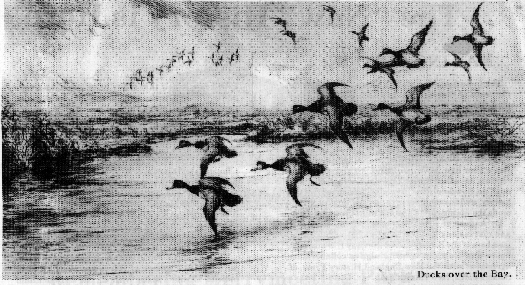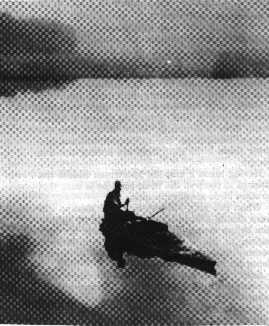 Ducks over the
Bay.
Ducks over the
Bay. Ducks over the
Bay.
Ducks over the
Bay.Darton's Duck Shooting Farms lie in the very center of the finest duck shooting region in the state. The buildings are old, yet they are clean and comfortable, with open fireplaces to make even the cool, fall evenings cheerful.
The shooting is done from floating blinds over live decoys, where one has ample opportunity to test his skill. The blinds are large enough to accommodate two sportsmen, so that both may enjoy fine shooting, providing one of the party understands the handling of a boat and decoys, so that no guide will be required. A shore blind, completely equipped with live decoys, is also available for the use of guests when the weather is too rough to be out on the Bay. We also have a swamp blind, where fair shooting can be had when the season's rainfall has been normal. During very dry seasons, this blind will not be used.
Darton's aims to furnish first class equipment and trustworthy guides; good decoys, and plenty of them. The guides at Darton's will not shoot, unless they are asked to do so by the sportsmen they are guiding.
The living quarters at Darton's are located about a four-minute walk from the shore of the Bay. 'The various blinds are placed at short distances from the shore, and seldom more than a half-mile away. Maine resident sportsmen must come with hunting licenses; and for nonresidents, licenses can be obtained at the Farm at a cost of $5.00 each, being good until November 1, after which a $15.00 license is required. It is legal to shoot from one-half hour before sunrise, right through to sunset, on weekdays. We are often asked what is the best time of year to enjoy good shooting. Our answer is, "almost anytime during the season when we can accommodate you, and when you can spend enough time to be on the grounds when one or more flights arrive."
Darton's appeals to the sportsman who enjoys the exhilaration and excitement of a game requiring patience, concentration, and skill. To be assured of enjoying the best of the sport, one should plan to spend a week or ten days. The shooting season opens September 16, with accommodations being furnished for sportsmen up to and including November 16. We are thoroughly equipped for duck shooting only, but we are close at hand to fine hunting of woodcock, partridge, snipe, fox and deer.
|
HOW THE GAME IS PLAYED AT DARTON'S Flat-bottomed boats of ample size for two people with all equipment, part of which is a portable blind, are used. A smaller boat is towed behind the larger one to the spot selected to hunt from. It is taken alongside and hidden from view by a portable screen of grass and branches before the shooting starts. This small boat is for use in picking up the dead birds, as it is quicker and easier than moving the larger boat, with its trimming, or blind, in position, especially if it is a windy day. Places have been preselected to hunt from in the bay, and two stakes are driven to mark the spot and supply the mooring for the boats. Near the stakes, all the grass has been cut to make a small, open pond for the placing of decoys. A trawl line some 150 feet long is stretched across the open space, about twenty yards from the shooting boat; and, at intervals of twenty feet, the line has attached snap lines that measure seven feet long. This trawl line, anchored at both ends, is used with the snap lines to tether the live decoys. In each flat boat is a duck box containing live decoys, and about a dozen or more wooden decoys. On arriving at the spot selected, pick up the buoy on |

|
the end of the trawl line and work the boat along this line, snapping to each snap line, one of the live decoys which are held by a strap attached to its leg. Four or more live decoys should be deployed in this manner.
Ducks coming into decoys always head into the wind, so the decoys should be placed to be readily seen, but where the wild ducks will have to pass the blind within gunshot range on their way to alight. The wooden decoys should be placed further away than the live ones, and should be well separated to prevent fouling. Next, push over to the mooring stakes, secure your boat by taking a turn around each with the short ropes attached to the sides of the boat. Make fast to the cleats, leaving slack enough so the boat will rise and fall with the tide. Bring the small, pick-up boat close in along the side opposite the decoys. Make it fast and cover it completely with the grass screen. Now, trim your flat boat with the four-piece sectional blind and get yourself ready for shooting. If two are shooting together, sit back to back, not only for safety, but this will enable you to more readily see descending birds.
Guns should be loaded by now. The majority of shots will be in one place, directly over the live decoys. The sportsmen's success in getting shots will depend to a great extent on his ability to remain quiet and still, well concealed, and ready to act. Watch for the birds to appear over the decoys. Keep a sharp lookout to leeward, as the best shots come from that quarter. Do not try to see how far away you can see ducks, for they will always see your movements first, and their suspicions will be aroused. Many a chance is lost that would have been a fine shot, if only the sportsman had kept down and quiet. When ducks intend to come over the decoys and have approached, say within 100 yards, and the sportsman has discovered them, this is indeed the crucial moment. At this distance, they appear to be within range, but to move now is fatal. Keep perfectly still until they have arrived; then, with feet firmly planted in the center of the boat, stand up quickly, select a bird, hold well ahead, and shoot. Should the ducks alight before you can shoot, scare them up, but be careful to hold well over your bird, or you will surely shoot under him.
Often, birds that are wary will alight well outside the decoys, and, if nothing occurs to alarm them, they will usually swim in and join the decoys. Sometimes, the sportsman will not discover these birds until they are among the live decoys. Having made a kill, the sportsman should not attempt to retrieve the birds until he is sure that no other birds are approaching. When two men are shooting, the man to leeward should always allow the birds to go up past him before standing up. This will allow his companion to get a shot also. When birds have become unusually wary, often times a "flyer" decoy can be used to advantage.
Safety first is our motto. When the day's sport is over, guns should be unloaded before coming ashore. Do not bring loaded guns ashore.
Sportsmen not accompanied by a guide will be held responsible for the safe return of all outfit supplied them by the management. Care must be used in handling our live decoys, and should any of them be lost or shot through carelessness, a charge will be made for the bird. Wooden decoys should not be left out overnight. Sportsmen returning ashore at night are met by a shore boy who will take charge of all equipment, thus leaving the sportsman free to prepare for the hearty dinner awaiting him at the big house.
The best shooting is usually enjoyed at high tide, yet good shooting is often found at low tide. At such times when the tide serves right for a very early start, a hearty breakfast will be served. Sportsmen will be provided with a substantial lunch and hot drink to take with them each morning. In the early morning, when it is very still on approaching the shore of the Bay, loud conversation and all unnecessary noise will have to be avoided, or many ducks will be disturbed. Always be as quiet as possible.
Our boats are tight, clean, comfortable, and seaworthy. Properly handled, they are safe for any weather. Each hunting boat is equipped with a good pair of oars, a pole, a water jug, painter and anchor, bailing dish and sponge, and comfortable life preserver cushions. While hunting on Merrymeeting Bay, never leave your boat under any conditions. Should your boat go adrift you probably could not recover it, and your chances of reaching shore without it would not be very good.
Many sportsmen on their way to the big game regions in the Maine woods pass within three miles of Darton's, either by rail or automobile. Why not break the trip by stopping over and having a few days with the ducks? We are said to have the best outfits in New England for duck shooting.
HOW TO GET THERE
The Darton Farms are located three miles from Bowdoinham Village, on the shore of Merrymeeting Bay. The Bay, which is formed by the Androscoggin, Muddy, Cathance, and Abagadassett rivers joining the Kennebec, embraces an area of several thousand acres, mostly of shallow water. It averages two miles wide and perhaps seven miles long. The Bay is about twenty miles from the sea coast.
The water of the Bay is fresh, yet it is also tidal and grows a wealth of wild rice, widgeon grass, etc., for feeding the thousands of wild fowl which congregate there during the shooting season. The black duck is the principal bird in this region, but during the season, many other varieties such as teal, widgeon, bluebills, whistlers and a few mallard, redhead and canvasback are taken.
BOWDOINHAM is situated on the Maine Central Railroad, 37 miles east of Portland, and also lies on the Maine State Motor Highway. Guest arriving by rail will be met at the station and conveyed to the farms by auto. Guests coming by auto from Boston or more western points should leave Boston by the Newburyport Turnpike, passing through Portland, Brunswick, and Bowdoinham. On leaving Bowdoinham village, proceed in the direction that the cannon opposite the Post Office points. Cross a small bridge, climb a small hill, cross two other small bridges, climb a larger hill to a church on the right, about one mile from the post office. At this point take the right hand road, crossing the railroad tracks, proceed to the second right hand road at the old schoolhouse. Turn here, and Darton's is one mile down from the school house, on the right hand side of the road.
Be assured that nowhere can you get more exhilarating sport, more exciting and thoroughly satisfying recreation than you can obtain at Darton's Farm, in Bowdoinham in the midst of the greatest duck shooting in the state.
Bowdoinham Advertiser &endash; August 1985
Frank Connors, Editor